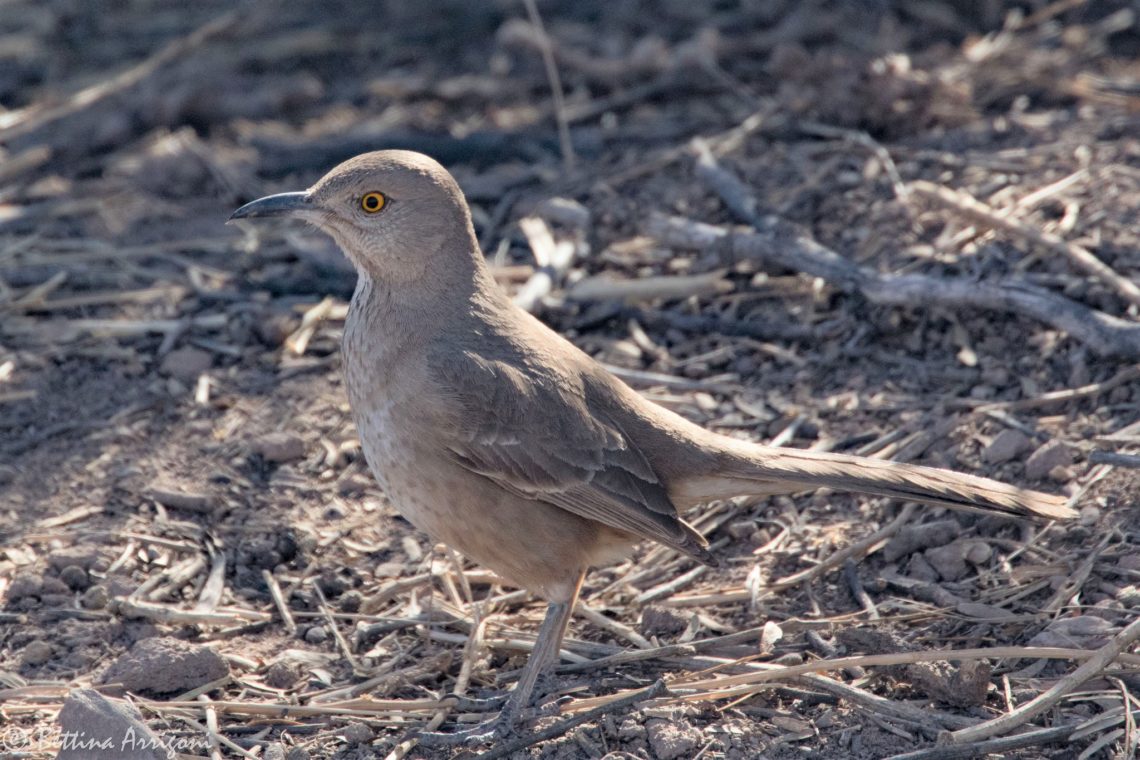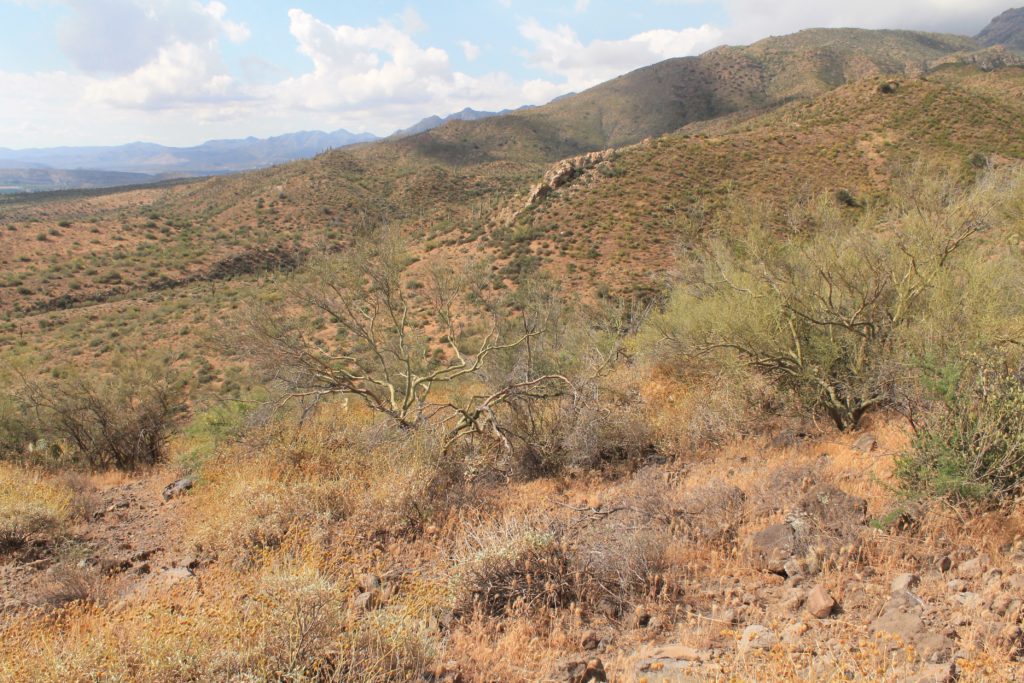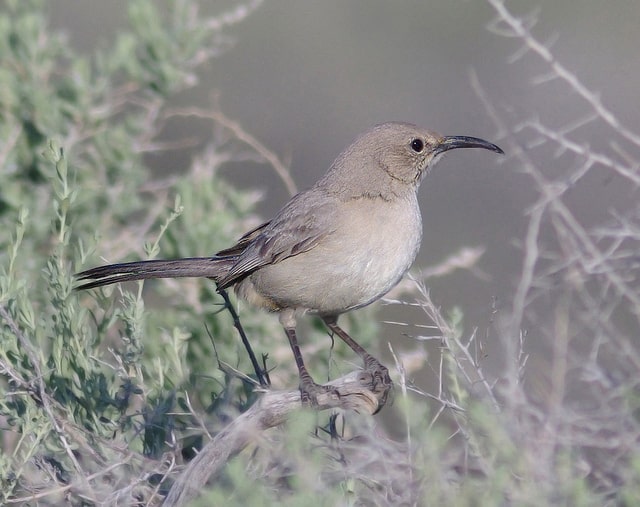
A Bendire’s Thrasher moves beneath the desert scrub (photo courtesy of Bettina Arrigoni, shared with a CC 2.0 license).
By Chris McCreedy, Research Associate, Point Blue Conservation Science
Deserts are demanding environments with steep costs and big rewards. Extreme temperatures and extended periods of insignificant precipitation can present serious challenges for plants and animals, limiting food and water and requiring significant physiological adaptations in order to survive. Those adaptations result in desert endemism, and our North American deserts are full of species of plants and animals whose geographic distributions are often entirely restricted to the deserts in which they thrive.
Ten thrasher species populate the Toxostoma genus, a group of relatively large mimids with long tails, often (though not always) yellow or orange-irised eyes, and long, downward pointing, U-shaped bills. Six of them, Bendire’s Thrasher, LeConte’s Thrasher, Crissal Thrasher, Curve-billed Thrasher, California Thrasher, and Gray Thrasher breed within the Sonoran Joint Venture’s binational boundary.

Typical habitat in which surveyors sample for desert thrashers (photo courtesy of Tim Flood and the DTWG).
The Toxostoma thrashers of the desert Southwest exist in low densities, hold large territories, have small clutch sizes, and must survive prolonged intervals of heat and drought. Yet desert habitats of the southwestern United States are a noted climate change hotspot, with increased drought frequency and elevated temperatures predicted over coming decades. Partners in Flight’s (PIF) North American Bird Conservation Initiative (NABCI) recently identified arid lands as having birds experiencing the most steeply declining of all national habitat indicators due to habitat loss, fragmentation, and drought. These conditions lay the foundation for a perilous future for our Toxostoma thrashers of the deserts.
NABCI has identified Bendire’s Thrashers (Toxostoma bendirei) and LeConte’s Thrashers (Toxostoma lecontei) as the two-fastest declining species of the arid lands habitat indicator. Due to the above-listed threats to arid lands and because of thrashers’ biology and endemism, NABCI has placed Bendire’s Thrashers and LeConte’s Thrashers on its U.S. Continental Red List, which our holds 42 bird species of highest conservation concern.
Using North American Breeding Bird Survey (NABBS) data, researchers have found the expected ‘population half-life’ (time to expected 50% population decline) to be only 18 years for Bendire’s Thrasher and 29 years for LeConte’s Thrasher. These authors also calculate a time to minimum monitoring threshold (time in which the species decline to levels at which it becomes essentially undetectable via the NABBS) for Bendire’s Thrasher at 50-75 years.
The Desert Thrasher Work Group (DTWG) has been created to develop best management practices, guide thrasher conservation, produce scientific manuscripts, and increase public awareness of thrasher decline. The DTWG is comprised of federal and state agencies, nonprofits, academics, and consulting professionals. With funding support from the Bureau of Land Management members of the DTWG began a multi-year investigation of LeConte’s and Bendire’s Thrasher populations in California (Point Blue Conservation Science), Nevada (Great Basin Bird Observatory), and Arizona (Arizona Game and Fish Department). We surveyed 200 plots across the three states, testing and refining the DTWG’s standardized survey protocol during the field season.

The LeConte’s Thrasher is distinguished partially by its paler coloration and long, de-curved bill (photo courtesy of Alan Schmierer, Creative Commons).
With continued funding support from the Bureau of Land Management, the DTWG will continue surveys in California, Nevada, and Arizona, and we will begin additional surveys in Utah (Utah Division of Wildlife Resources) and New Mexico (New Mexico Department of Game and Fish). We expect that we will survey approximately 500 plots across the five-state study area this year alone. The objectives of these surveys are to estimate distribution, determine population trends over time, and to identify habitat preferences for Bendire’s and LeConte’s Thrashers across their respective ranges.
We are excited that the Sonoran Joint Venture has added desert thrasher locations to its avicaching event this spring. While DTWG biologists are covering more ground than ever before, the desert is a big place! In addition, Bendire’s Thrasher populations on the perimeter of the species’ geographic distribution are migratory, and their presence, phenology, and densities can change greatly from one year to the next. As a result, the more coverage, the more eyes on the ground that we can recruit to these locations, the better our understanding of Toxostoma thrashers will be. Avicachers can help us to determine if and when adults arrived and perhaps unexpectedly departed a site due to drought, your observations can give us insight into singing and even breeding phenology if avicachers report fledglings, and avicachers help us to provide inter-annual data continuity at sites if funding or logistics prohibit biologists from revisiting a site in the future. Your checklists matter, and we are grateful.


 English
English  Español
Español